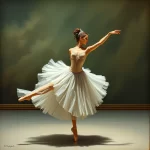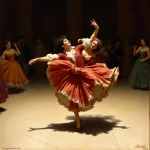Ballet: La Bayadère (Marius Petipa, 1877)

Introduction
Ballet, an art form that combines dance, music, and storytelling, has produced many timeless masterpieces. One such work is “La Bayadère,” choreographed by Marius Petipa with music composed by Ludwig Minkus. Premiering on February 4, 1877, at the Imperial Bolshoi Kamenny Theatre in St. Petersburg, Russia, “La Bayadère” is a tale of love, betrayal, and redemption set against the exotic backdrop of ancient India.
The ballet follows the tragic love story of Nikiya, a temple dancer (bayadère), and Solor, a noble warrior. Their love is thwarted by jealousy and deceit, leading to a dramatic and otherworldly conclusion. “La Bayadère” remains a staple in the classical ballet repertoire, celebrated for its rich choreography, evocative music, and compelling narrative.
Historical Background
Creation and Development
“La Bayadère” was created during a period of significant cultural and artistic development in Russia. The late 19th century was a time when Russian ballet was flourishing, heavily influenced by French and Italian traditions. Marius Petipa, a French ballet master who had settled in Russia, was at the forefront of this movement. His collaboration with Ludwig Minkus, an Austrian composer known for his work in ballet, resulted in several successful productions, including “La Bayadère.”
The inspiration for “La Bayadère” came from various sources, including Indian literature and folklore. The exotic setting and themes of love and betrayal were popular in European art and literature at the time, reflecting a fascination with the “Orient.” Petipa’s vision for the ballet was to create a grand spectacle that combined dramatic storytelling with intricate choreography.
Premiere and Reception
“La Bayadère” premiered on February 4, 1877, at the Imperial Bolshoi Kamenny Theatre in St. Petersburg. The initial reception was mixed, with some critics praising the ballet’s visual and musical elements while others found the plot convoluted. However, the ballet quickly gained popularity, thanks in part to the performances of the original cast, including Ekaterina Vazem as Nikiya and Lev Ivanov as Solor.
Over the years, “La Bayadère” has seen numerous revivals and reinterpretations, solidifying its place in the classical ballet canon. Notable early performances include those by the Ballets Russes in the early 20th century, which helped introduce the ballet to Western audiences.
Synopsis of the Ballet
Act I Summary
The ballet opens in a temple in ancient India, where Nikiya, a beautiful temple dancer, is in love with Solor, a noble warrior. Their love is forbidden, as Nikiya is dedicated to the gods. The High Brahmin, who is also in love with Nikiya, discovers their secret and vows to destroy Solor. Meanwhile, the Rajah Dugmanta of Golconda has promised Solor’s hand in marriage to his daughter, Gamzatti. Unaware of Solor’s love for Nikiya, Gamzatti falls in love with him at first sight.
Act II Summary
In the second act, the Rajah announces the engagement of Solor and Gamzatti. Nikiya is heartbroken and confronts Gamzatti, pleading with her to call off the engagement. Gamzatti, however, is determined to marry Solor and orders Nikiya to be killed. During the engagement celebration, Nikiya is forced to dance and is given a basket of flowers containing a deadly snake. She is bitten and dies, but not before Solor vows to be with her in the afterlife.
Act III Summary
The final act takes place in the Kingdom of the Shades, a mystical realm where the spirits of the dead reside. Solor, tormented by guilt and grief, dreams of being reunited with Nikiya. In a famous scene known as the “Kingdom of the Shades,” the spirits of the temple dancers descend a moonlit mountain in a mesmerizing procession. Solor and Nikiya’s spirits are finally reunited, symbolizing the triumph of eternal love over earthly obstacles.
Finale
The ballet concludes with Solor and Nikiya’s spirits ascending to the heavens, leaving behind the mortal world and its sorrows. This ethereal ending underscores the themes of love, sacrifice, and redemption that run throughout the ballet.
Musical Composition
Composer’s Role
Ludwig Minkus, an Austrian composer, played a crucial role in bringing “La Bayadère” to life. Known for his work in ballet, Minkus’s compositions are characterized by their melodic richness and rhythmic vitality. His score for “La Bayadère” is no exception, featuring a blend of lyrical passages and dramatic crescendos that enhance the ballet’s emotional depth.
Musical Themes and Motifs
The music of “La Bayadère” is marked by recurring themes and motifs that reflect the characters’ emotions and the narrative’s progression. For instance, Nikiya’s theme is delicate and melancholic, capturing her purity and tragic fate. In contrast, Solor’s theme is more robust and heroic, reflecting his noble character. The use of leitmotifs helps to unify the ballet’s various scenes and underscore its dramatic moments.
Famous Recordings and Performances
Several recordings of “La Bayadère” have been made over the years, capturing the beauty of Minkus’s score. Notable performances include those by the Kirov Ballet (now the Mariinsky Ballet) and the Bolshoi Ballet, both of which have produced acclaimed recordings of the ballet’s music. These recordings continue to be popular among ballet enthusiasts and serve as a testament to Minkus’s enduring contribution to the art form.
Choreography and Dance
Choreographer’s Vision
Marius Petipa’s vision for “La Bayadère” was to create a grand spectacle that combined dramatic storytelling with intricate choreography. His interpretation of the ballet is characterized by its elaborate set pieces, complex group dances, and expressive solos. Petipa’s choreography is known for its precision and elegance, requiring dancers to possess both technical skill and emotional depth.
Signature Dance Numbers
“La Bayadère” features several signature dance numbers that have become iconic in the world of ballet. One of the most famous is the “Kingdom of the Shades” scene, where a line of ballerinas in white tutus descend a moonlit mountain in perfect unison. This scene is celebrated for its visual beauty and technical difficulty, requiring impeccable timing and coordination from the dancers.
Another notable dance is the Pas de Deux between Nikiya and Solor, which showcases their love and longing through a series of intricate lifts and turns. This duet is a highlight of the ballet, demonstrating the dancers’ technical prowess and emotional connection.
Notable Interpretations
Over the years, “La Bayadère” has been interpreted and adapted by various choreographers and ballet companies. Some productions have stayed true to Petipa’s original choreography, while others have introduced new elements or modernized the ballet’s staging. Notable interpretations include those by Rudolf Nureyev, Natalia Makarova, and Yuri Grigorovich, each of whom brought their unique vision to the ballet.
Characters and Roles
Main Characters
- Nikiya: A temple dancer (bayadère) who is in love with Solor. She is pure-hearted and devoted, but her love leads to her tragic demise.
- Solor: A noble warrior who loves Nikiya but is betrothed to Gamzatti. He is torn between duty and love, ultimately seeking redemption in the afterlife.
- Gamzatti: The Rajah’s daughter, who is determined to marry Solor. She is beautiful and strong-willed but becomes a central figure in the ballet’s conflict.
- The High Brahmin: A priest who is in love with Nikiya and seeks to destroy Solor out of jealousy.
Supporting Characters
- Rajah Dugmanta: The ruler who arranges Solor’s marriage to his daughter, Gamzatti.
- Magdaveya: A fakir who helps Nikiya and Solor in their secret meetings.
- Temple Dancers: A group of dancers who perform in the temple and play a significant role in the ballet’s group scenes.
Famous Dancers
Many renowned dancers have portrayed the roles in “La Bayadère” over the years. Notable performers include Natalia Makarova, who is celebrated for her portrayal of Nikiya, and Rudolf Nureyev, who brought a new level of intensity to the role of Solor. Other famous dancers include Altynai Asylmuratova, Svetlana Zakharova, and Carlos Acosta, each of whom has left their mark on the ballet.
Cultural and Artistic Impact
Influence on Ballet and Dance
“La Bayadère” has had a significant influence on the world of ballet and dance. Its intricate choreography and dramatic storytelling have inspired countless choreographers and dancers. The ballet’s themes of love, betrayal, and redemption continue to resonate with audiences, making it a timeless work that remains relevant today.
Cultural Significance
The ballet’s exotic setting and themes have also contributed to its cultural significance. “La Bayadère” reflects the 19th-century European fascination with the “Orient” and has been referenced in various forms of popular culture, literature, and other media. Its influence can be seen in films, theater productions, and even fashion, where elements of the ballet’s aesthetic have been incorporated.
Legacy and Revivals
“La Bayadère” has seen numerous revivals and reinterpretations over the years, each bringing new life to the ballet. Major revivals include those by the Kirov Ballet, the Bolshoi Ballet, and the Royal Ballet, all of which have produced acclaimed productions. The ballet continues to be performed and celebrated today, with new generations of dancers and audiences discovering its beauty and emotional depth.
Iconic Productions
Historic Productions
Some of the most famous historical productions of “La Bayadère” include those by the Ballets Russes in the early 20th century. These productions helped introduce the ballet to Western audiences and featured some of the most renowned dancers of the time, including Anna Pavlova and Vaslav Nijinsky. The Kirov Ballet’s 1941 revival, staged by Agrippina Vaganova, is also notable for its fidelity to Petipa’s original choreography.
Contemporary Productions
Recent productions of “La Bayadère” have brought new interpretations and innovations to the ballet. The Royal Ballet’s 1989 production, staged by Natalia Makarova, is celebrated for its dramatic intensity and technical precision. Other contemporary productions have experimented with modern staging and design elements, offering fresh perspectives on the classic ballet.
Production Design
The set, costume, and lighting design in various productions of “La Bayadère” have played a crucial role in bringing the ballet’s exotic world to life. Traditional productions often feature elaborate sets depicting temples, palaces, and mystical realms, while costumes reflect the rich colors and intricate patterns of Indian attire. Lighting design is used to create mood and atmosphere, particularly in scenes like the “Kingdom of the Shades,” where moonlit effects enhance the ethereal quality of the dance.
Critical Reception and Reviews
Initial Critical Response
At the time of its premiere, “La Bayadère” received mixed reviews from critics. While some praised the ballet’s visual and musical elements, others found the plot convoluted and criticized its exoticism. However, the performances of the original cast, particularly Ekaterina Vazem as Nikiya, were widely acclaimed.
Modern Reviews
Contemporary critics and audiences have a more favorable view of “La Bayadère,” recognizing it as a masterpiece of classical ballet. The ballet is celebrated for its intricate choreography, emotional depth, and evocative music. Modern productions continue to receive positive reviews, with critics praising the skill and artistry of the dancers and the innovative staging of the ballet.
Fun Facts and Trivia
Behind-the-Scenes Stories
One interesting anecdote from the original production of “La Bayadère” involves Ekaterina Vazem, who played Nikiya. During rehearsals, she was bitten by a real snake used in the basket scene. Fortunately, she recovered quickly and continued with the performance, but the incident led to the use of a fake snake in future productions.
Notable Performers
Over the years, many famous dancers have been associated with “La Bayadère.” Rudolf Nureyev’s portrayal of Solor is particularly noteworthy, as he brought a new level of intensity and passion to the role. Natalia Makarova’s interpretation of Nikiya is also celebrated for its emotional depth and technical precision.
Trivia
- “La Bayadère” was one of the first ballets to feature a “white act,” where dancers appear in white tutus against a moonlit backdrop. This concept was later used in other famous ballets like “Giselle” and “Swan Lake.”
- The “Kingdom of the Shades” scene is considered one of the most challenging group dances in classical ballet, requiring perfect synchronization from the dancers.
- Ludwig Minkus composed the score for “La Bayadère” in just three months, a testament to his skill and creativity as a composer.
Conclusion
Summary of the Ballet’s Importance
“La Bayadère” is a significant work in the world of ballet, known for its intricate choreography, evocative music, and compelling narrative. The ballet’s themes of love, betrayal, and redemption continue to resonate with audiences, making it a timeless masterpiece that remains relevant today.
Final Thoughts
Reflecting on “La Bayadère,” it is clear why this ballet has endured for over a century. Its combination of dramatic storytelling, technical brilliance, and emotional depth makes it a standout work in the classical ballet repertoire. Whether you are a seasoned ballet enthusiast or a newcomer to the art form, “La Bayadère” offers a captivating experience that is well worth exploring.
We encourage readers to watch a performance of “La Bayadère” or listen to its beautiful score to fully appreciate the artistry and emotion that this ballet has to offer.
FAQ
What is the central theme of this ballet?
The central theme of “La Bayadère” is the tragic love story between Nikiya, a temple dancer, and Solor, a noble warrior. The ballet explores themes of love, betrayal, and redemption.
Who are the main characters in this ballet?
The main characters in “La Bayadère” are Nikiya, a temple dancer; Solor, a noble warrior; Gamzatti, the Rajah’s daughter; and the High Brahmin, a priest who is in love with Nikiya.
What is the most famous dance number in this ballet?
The most famous dance number in “La Bayadère” is the “Kingdom of the Shades” scene, where a line of ballerinas in white tutus descend a moonlit mountain in perfect unison.
How long does a typical performance of this ballet last?
A typical performance of “La Bayadère” lasts approximately two and a half to three hours, including intermissions.
Are there any modern adaptations of this ballet?
Yes, there have been several modern adaptations of “La Bayadère,” including productions by the Royal Ballet, the Bolshoi Ballet, and other major ballet companies. These adaptations often introduce new elements or modernize the staging while staying true to the original choreography.
Why is this ballet considered important in the history of dance?
“La Bayadère” is considered important in the history of dance because of its intricate choreography, evocative music, and compelling narrative. It has influenced countless choreographers and dancers and remains a staple in the classical ballet repertoire.





